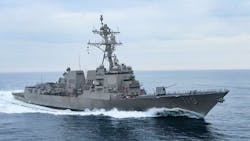Navy eyes multi-aperture antennas to enhance electronic warfare (EW) operations aboard surface warships
SAN DIEGO – U.S. Navy electronic warfare (EW) experts are surveying industry to find companies able to perform communications, electronic support, and electronic attack from the same antenna array aboard naval surface warships.
Officials of the Naval Information Warfare Center-Pacific in San Diego issued a request for information (NIWC_Pacific_MKTSVY_1754EE) on Tuesday for the Active Electronically Steered Array (AESA) and Phased Array Fed Reflector (PAFR) project.
Navy experts want to identify companies able to determine if active electronically steered array (AESA) and phased-array fed reflector antennas can provide wideband high UHF thru SHF transmit and receive capability at very high effective isotropic radiated power and gain over temperature.
These capabilities must come in small size, weight, power consumption, cooling, and cost package. The transmit and receive aperture must be no larger than 73 inches high, 73 inches in diameter, have a deck-mounted support pedestal no higher than 24 inches, and weigh no more than 1,000 pounds.
Navy experts say they need the ability conduct communications, electronic support, and electronic attack operations aboard surface warships from one small aperture to face current and future threats. A wideband high effective isotropic radiated power transmit and receive array across at least S- though X-band, as well as a lower effective isotropic radiated power transmit capacity and receive capacity in L- through Ku- bands is necessary to do this.
Given the limits of available shipboard topside space, the Navy wants to make electronic support and electronic attack functions available from the same aperture.
Each proposed solution must be a modular design that can be configured to several different missions, and use technology mature enough to validate in a simulated environment (TRL-6).
Companies interested should email white papers no later than 5 Feb. 2021 to the Navy's Scott Henrikson at scott.a.henriksonatnavy.mil. Email questions or concerns to Scott Henrikson at scott.a.henriksonatnavy.mil.
More information is online at https://beta.sam.gov/opp/74d3976717f24ba7afde06318b48a96c/view.
About the Author
John Keller
Editor-in-Chief
John Keller is the Editor-in-Chief, Military & Aerospace Electronics Magazine--provides extensive coverage and analysis of enabling electronics and optoelectronic technologies in military, space and commercial aviation applications. John has been a member of the Military & Aerospace Electronics staff since 1989 and chief editor since 1995.
